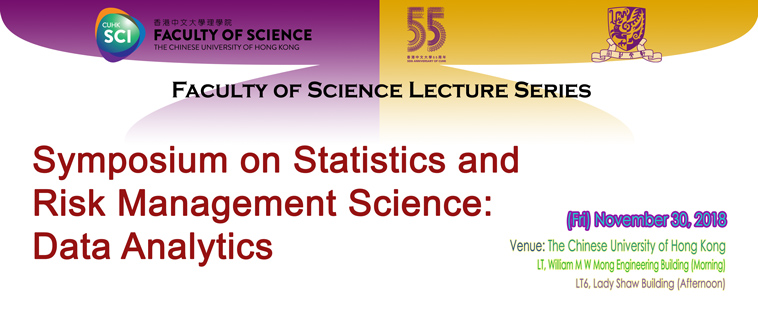Title: Evolutionary Credibility Risk Premium
Abstract: In this talk, we study the problem of the risk premium calibration under an evolutionary credibility model in which both the hypothetical mean and the process variance are simultaneously estimated. The procedure is carried out by minimizing the mean squared loss with respect to both quantities by solving the corresponding normal equations. It is worth noticing that our formulation and procedure are model-free and are different from both the SURE estimate proposed by Xie et al. (2012), which assumes heteroscedastic but known variances, and that by Jing et al. (2016), which focuses on single time period only. We devise an effective recursive $LU$ algorithm for solving the sets of normal equations, and study several special cases of the evolutionary model. The superior performance of our procedure compared to existing methodologies will be illustrated through simulation studies. This talk is based on a joint work with Yongzhao Chen, Hugo Choi, Tze Leung Lai, and Phillip Yam. |

Ka Chun CHEUNG
The University of Hong Kong
|
Title: Causal Mediation of Semicompeting Risks
Abstract: The semi-competing risk problem arises when one is interested in the effect of an exposure or treatment on both intermediate (e.g., having cancers) and primary (e.g., death) events where the intermediate event may be censored by the primary event but not vice versa. Here we propose a nonparametric approach by casting the semi-competing risk problem in the framework of causal mediation modeling. We set up a mediation model with the intermediate and primary events, respectively as the mediator and the outcome, and define indirect effect (IE) as the effect of the exposure on the primary event mediated by the intermediate event and direct effect (DE) as that not mediated by the intermediate event. A time-varying weighted Nelson-Aalen type of estimators are proposed for direct and indirect effects where the counting process at time t of the primary event N_(2n_1 ) (t) and its compensator A_(n_1 ) (t) are both defined conditional on the status of the intermediate event right before t, N_1 (t^- )=n_1. We show that N_(2n_1 ) (t)-A_(n_1 ) (t) is a zero-mean martingale. Based on this, we further establish asymptotic unbiasedness, consistency and asymptotic normality for the proposed estimators. Numerical studies including simulation and data application are presented to illustrate the finite sample performance and utility of the proposed method.
Keywords: Causal inference; Causal mediation model; Martingale; Nelson-Aalen estimator; Semi-competing risk |

Yen-Tsung HUANG
Academia Sinica
|
Title: Implementation Shortfall for Algorithmic Trading
Abstract: Implementation shortfall (Perold, 1988) is defined as the profit and loss difference between paper and real portfolio, and it is composed of execution cost and opportunity cost. However, the framework of Perold (1988) is not directly applicable to algorithmic trading because the method has a rigid requirement on the time stamp of the trade records of the paper and real portfolio. In this paper, we propose a framework to compute implementation shortfall for algorithmic trading. We employ an efficient algorithm inspired by DNA sequence alignment techniques to compute the implementation shortfall with a breakdown of execution cost and opportunity cost. Our proposed framework is simple and computationally efficient. In particular, the complexity of our framework only grows linearly with the number of trades on backtesting or live trading. Hence our framework is applicable to even high frequency trading data.
|

Alfred MA
CASH Algo Finance Group Limited
|
Title: Prepare for the New Trends in Insurance Analytics
Abstract: Insurance industry hasn’t changed in the last 30 years. The product offer and distribution model are basically the same and the adoption of technology is slow compared with other industries. Ironically, there are many Actuaries working in this industry who are experts to apply statistics and mathematic to business. I would like to share my thought about the problem and how Actuaries or Statisticians can disrupt the insurance industry.
Intermediaries are critical in the insurance ecosystem as the communication is not effective in the past. They serve as the bridge between customers and insurance companies. Most insurance executives will think Life Insurance is a people business and reluctant to adopt technology to partially replace the role of intermediaries. It is quite different to other financial institutions and can explain why they can move faster in the digitalization journey.
In retail business, e-commerce grows dramatically in the last 10 years. Alibaba and Amazon becomes the largest retail business companies in the world. Their business model is to cut down the intermediaries and deliver the products to customers directly at low price. Most importantly, these companies analyze the customer data and able to offer a right product at right time. These two companies started to develop their insurance business in a completely different ways of business model. They don’t need intermediaries but they need data expert to analyze the data. Unlike other industries, insurance heavily involve statistics and life contingency, only Actuaries and Statisticians really know how to handle those data. The role of Actuaries will not be limited to traditional pricing and valuation roles. Instead, they need understand the customer through data and helping insurance to serve the customers directly. It sounds reasonable and promising but how they can make it. Let me share my thought in the following 30 minutes.
|

Ben NG
Coherent Capital Advisors, Ltd
|
Title: Jackknife Approach to the Estimation of Mutual Information
Abstract: Quantifying the dependence between two random variables is a fundamental issue in data analysis, and thus many measures have been proposed. Recent studies have focused on the renowned mutual information (MI) [Reshef DN, et al. (2011) Science 334:1518–1524]. However, “Unfortunately, reliably estimating mutual information from finite continuous data remains a significant and unresolved problem” [Kinney JB, Atwal GS (2014) Proc Natl Acad Sci USA 111:3354–3359]. In this paper, we examine the kernel estimation of MI and show that the bandwidths involved should be equalized. We consider a jackknife version of the kernel estimate with equalized bandwidth and allow the bandwidth to vary over an interval. We estimate the MI by the largest value among these kernel estimates and establish the associated theoretical underpinnings. |

Howell TONG
University of Electronic Science and Technology of China / London School of Economics and Political Science
|
Title: Enhancing Power of Association Test in Whole Genome Sequencing Data by a Fuzzy Zoom-Focus Algorithm
Abstract: The increasing amount of whole exome or genome sequencing data brings forth the challenge of analyzing the association of rare variants that have extremely small minor allele frequencies. Various statistical tests have been proposed, which are specifically configured to increase power for rare variants by conducting the test within a certain bin, such as a gene or a pathway. However, a gene may contain from several to thousands of markers, and not all of them are related to the phenotype. Combining functional and non-functional variants in arbitrary genomic region could impair the testing power. We propose a Fuzzy Zoom-Focus algorithm (fZFA) to locate the optimal testing region within a given genomic region. It can be applied as a wrapper function of existing rare variant association tests to increase testing power. The algorithm is very efficient and the complexity is linear to the number of variants. Simulation studies showed that fZFA substantially increased the statistical power of rare variants tests, including the burden test, SKAT, SKAT-O, and the W-test. The algorithm was applied on real exome sequencing data of hypertensive disorder, and identified biologically relevant genetic markers to metabolic disorder that were undiscoverable by gene-based method. The proposed algorithm is an efficient and powerful tool to enhance the power of association study for whole exome or genome sequencing data. |

Maggie Haitian WANG
The Chinese University of Hong Kong
|
Title: A Statistical Method to Quantify the Impact of Genetically Regulated Gene Expression on Complex Traits
Abstract: Genome-wide association studies (GWAS) have identified many risk variants associated with human complex phenotypes since 2005. However, nearly 90% of the risk variants are located in the non-coding region, highlighting the regulatory role of genetic variants. A scientific hypothesis is that a substantial proportion of risk variants affect complex traits/diseases through regulating expression of their target gene. In this talk, we discuss how to formulate the examination of this scientific hypothesis as a statistical problem and then develop a statistical method to address the challenge associated with this problem. |

Can YANG
Hong Kong University of Science and Technology
|
Title: Control Perspective for Rare Events
Abstract: The rare events in randomly perturbed dynamical systems are very important in physics, chemistry and biology, since they describe the random and infrequent hoppings between metastable states. The traditional studies are based on the large deviation and the underlying variational structure, which have been proved to be successful in understanding the transition mechanism in many applications. Now the dynamical programming and optimal control play a new role in understanding the importance sampling and constructing potentially more useful numerical schemes, in particular in combination with the machine learning techniques. This talk will introduce this perspective, elaborate controlled diffusion process from rest point and general proposals in future.
|

Xiang ZHOU
City University of Hong Kong
|
ssss
|

